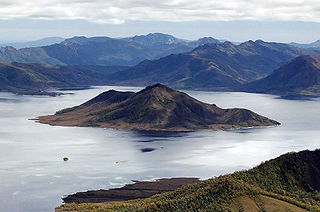This is a list of taxa comprising the flora of the Antipodes Islands. It includes some species known as megaherbs.
Contents
- Algae
- Fungi
- Lichens
- Liverworts
- Mosses
- Lycopods
- Ferns
- Flowering plants
- Monocotyledons
- Dicotyledons
- References

This is a list of taxa comprising the flora of the Antipodes Islands. It includes some species known as megaherbs.

In 1985, 116 species of marine algae were recorded at the Antipodes Islands. At least three species of freshwater algae have been recorded, but these have not yet been positively identified: a species of Chlorella , at least one species of Chlamydomonas , and a Xanthophyceae, perhaps Tetrakenton or Goniochloris .
The only fungi recorded from the Antipodes Islands are Puccinia caricina and a Claviceps (Ergot) species.
The following species of lichen have been recorded from the Antipodes Islands:
The following species of liverwort have been recorded from the Antipodes Islands:
The following species of moss have been recorded from the Antipodes Islands:
Three species of lycopod have been recorded from the Antipodes Islands:
The following species of fern have been recorded from the Antipodes Islands:
The following species of monocotyledon have been recorded from the Antipodes Islands:
The following species of dicotyledon have been recorded from the Antipodes Islands:

The Tasmanian temperate rain forests are a temperate broadleaf and mixed forests ecoregion in western Tasmania. The ecoregion is part of the Australasian realm, which includes Tasmania and Australia, New Zealand, New Guinea, New Caledonia, and adjacent islands.

Coprosma is a genus of flowering plants in the family Rubiaceae. It is found in New Zealand, Hawaiian Islands, Borneo, Java, New Guinea, islands of the Pacific Ocean to Australia and the Juan Fernández Islands.
This is a list of the flora of the Tubuai, an island in French Polynesia.
Victoria, Australia contains approximately 32,000 hectares of temperate rainforest in various regions, which represents 0.14% of the State's total area. The areas with rainforest include: East Gippsland, Strzelecki Ranges, Wilsons Promontory, Central Highlands, and Otway Ranges. The rainforests vary between cool temperate, warm temperate, and mixed cool temperate.

The flora of Lebanon includes approximately 2,600 plant species. Situated on the eastern coast of the Mediterranean Basin, Lebanon is a reservoir of plant diversity and one of the world's biodiversity hotspots for conservation priorities. Endemic species constitute 12% of the Lebanese flora; 221 plant species are broad endemics and 90 are narrow endemics. Important Plant Areas (IPAs) featuring the country exceptional botanical richness were defined in 2018.

The Botany of Lord Auckland's Group and Campbell's Island is a description of the plants discovered in those islands during the Ross expedition written by Joseph Dalton Hooker and published by Reeve Brothers in London between 1844 and 1845. Hooker sailed on HMS Erebus as assistant surgeon. It was the first in a series of four Floras in the Flora Antarctica, the others being the Botany of Fuegia, the Falklands, Kerguelen's Land, Etc. (1845–1847), the Flora Novae-Zelandiae (1851–1853), and the Flora Tasmaniae (1853–1859). They were "splendidly" illustrated by Walter Hood Fitch.